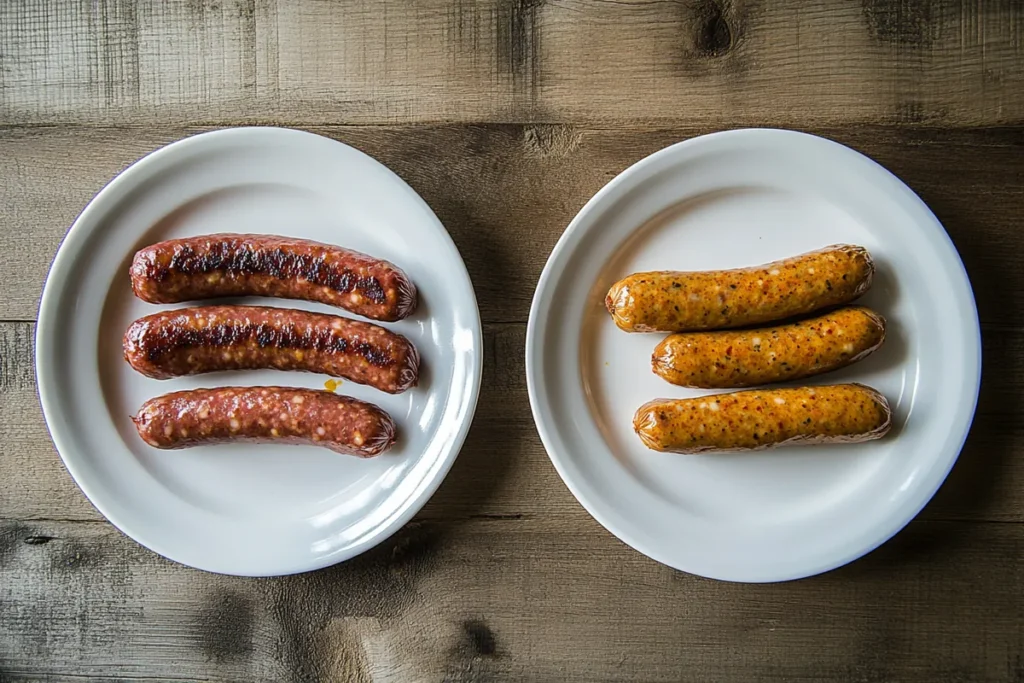When it comes to breakfast meats, you’ve likely encountered both chorizo and breakfast sausage on restaurant menus or in recipes. While both are popular choices for adding flavor and protein to your morning meal, they are not interchangeable. These sausages are distinct in their origins, ingredients, flavor profiles, and cooking methods. Let’s dive deeper into the characteristics that set chorizo apart from breakfast sausage and when you might want to choose one over the other.
What Is Chorizo?
Chorizo is a highly seasoned sausage, typically originating from Spain and Mexico. Spanish chorizo is cured and smoked, often resembling a hard sausage like salami, while Mexican chorizo is fresh and typically sold in bulk or casing form. The flavor is primarily derived from paprika, which gives it a distinct smoky and slightly spicy taste, depending on the type of chorizo you’re using.
Mexican chorizo, in particular, is known for its bold flavor, achieved by a combination of vinegar, paprika, chili powder, and garlic. This sausage is often used in breakfast burritos, chorizo and eggs, and other savory dishes that call for a punch of spice.
For a great recipe that uses chorizo, try this Chorizo Breakfast Burrito Recipe.
What Is Breakfast Sausage?
Breakfast sausage, on the other hand, is a much milder and more savory sausage. It’s a staple in American cuisine, typically made from ground meat, sage, and black pepper, with some variations including sweet flavors like maple. This sausage is perfect for breakfast sandwiches, biscuits and gravy, or simply served alongside scrambled eggs and toast.
The flavor of breakfast sausage is less bold compared to chorizo, which makes it versatile and suitable for a wide range of breakfast dishes.
If you’re looking to explore more traditional breakfast recipes, this article on What is Breakfast Pizza Made of? offers a great example of a popular dish that uses sausage in a creative way.
Key Differences Between Chorizo and Breakfast Sausage

While both sausages share some similarities, the differences between them are significant. Here’s a breakdown of the key distinctions:
1. Ingredients
- Chorizo: Made primarily from meat, seasoned heavily with paprika, vinegar, chili powder, and other spices. It can be either fresh (Mexican chorizo) or cured (Spanish chorizo).
- Breakfast Sausage: Also meat-based, but seasoned more mildly with sage, black pepper, and salt. Sometimes sweet flavors like maple syrup are added.
2. Flavor Profile
- Chorizo: Bold, spicy, and smoky. The paprika adds heat, while the vinegar provides a slight tang.
- Breakfast Sausage: Mild and savory, with a hint of sweetness depending on the variation. It lacks the smoky flavor that characterizes chorizo.
3. Cooking Method
- Chorizo: Typically crumbled and fried for use in various dishes. Spanish chorizo, being cured, can be eaten as is or lightly fried.
- Breakfast Sausage: Usually formed into patties or links and fried until cooked through. It can also be baked, making it a more versatile choice for traditional breakfasts.
For more about cooking methods, take a look at this recipe for Twice Baked Mashed Potatoes that could pair well with breakfast sausage.
Nutritional Comparison: Chorizo vs. Breakfast Sausage

Chorizo:
- Calories: Higher in calories, due to its fat content.
- Protein: Rich in protein, though the fat levels are also elevated.
- Sodium: Contains a significant amount of sodium, particularly in cured Spanish chorizo.
Breakfast Sausage:
- Calories: Lower in calories compared to chorizo.
- Protein: Also high in protein but generally contains less fat.
- Sodium: Contains less sodium than chorizo, depending on how it’s prepared.
Given the higher fat and sodium levels in chorizo, it’s best enjoyed in moderation. However, both can be part of a balanced diet when eaten responsibly.
History of Chorizo and Breakfast Sausage
The history of these two breakfast meats is rooted in their cultural origins. Chorizo has a long and rich history that dates back to Spain. The word “chorizo” itself is believed to have come from the Latin word “salsīcia,” which means salted. Spanish chorizo is heavily spiced with smoked paprika (pimentón), which was introduced to Europe from the Americas in the 16th century. Over time, regional variations of chorizo began to emerge, particularly in Latin American countries like Mexico, where the recipe was adapted to local tastes. Mexican chorizo tends to be fresher and spicier, using chili peppers instead of paprika to achieve its distinctive flavor.
In contrast, breakfast sausage is an American creation, popularized during the 19th century when sausage making became an efficient way to preserve meat. Breakfast sausage as we know it today has become a staple of American breakfast foods, heavily influenced by English sausages but adapted to include the herbs and spices available in the New World, like sage and black pepper. Today, many regional variations of breakfast sausage exist, from the mild sage-flavored sausages popular in the South to spicier varieties in other parts of the U.S.
Variations of Chorizo and Breakfast Sausage
As with many food items, both chorizo and breakfast sausage come in numerous regional and stylistic variations, each offering unique flavors and culinary uses.
Variations of Chorizo
- Spanish Chorizo: This variety is usually cured and smoked, much like salami. It’s often eaten sliced on its own or used to add a rich, smoky flavor to dishes like paella and stews. Spanish chorizo can range in flavor from sweet to spicy, depending on the type of paprika used.
- Mexican Chorizo: Unlike its Spanish counterpart, Mexican chorizo is uncured and raw. It is typically sold in links or bulk and must be cooked before consuming. Mexican chorizo is known for its bright red color, attributed to chili powder, and its strong, spicy flavor. It’s frequently crumbled and cooked with eggs, beans, or potatoes.
Variations of Breakfast Sausage
- Sage Breakfast Sausage: The classic American breakfast sausage is seasoned with sage, salt, and pepper. This sausage has a mild, herby flavor that pairs well with eggs and other breakfast staples.
- Maple Breakfast Sausage: A sweeter variation of the classic, maple-flavored breakfast sausage has become a popular option in recent years. It’s particularly popular in the Northeast, where maple syrup production is abundant. This sausage provides a sweet contrast to savory dishes like pancakes or waffles.
- Spicy Breakfast Sausage: For those who prefer a little heat in their breakfast, spicy versions of breakfast sausage are made by adding red pepper flakes or other spices. This version is particularly popular in the southern United States.
The Versatility of Chorizo and Breakfast Sausage
One of the reasons both chorizo and breakfast sausage remain so popular is their versatility in cooking. Each can be used in a wide array of dishes, making them essential ingredients in many kitchens.
Versatility of Chorizo
- Breakfast: Chorizo is commonly used in Mexican breakfasts, such as chorizo con huevos (chorizo with eggs), chorizo breakfast tacos, and even chorizo-stuffed burritos. Its bold flavor adds depth to these dishes.
- Lunch and Dinner: Beyond breakfast, chorizo is a frequent addition to hearty meals like paella, tacos, and stews. Its smoky, spicy flavor infuses dishes with warmth, making it a favorite in Spanish and Mexican cuisine.
- Appetizers and Snacks: Cured Spanish chorizo can be sliced and served on a charcuterie board, paired with cheeses and crackers. Its savory, smoky notes make it an ideal snack for gatherings.
Versatility of Breakfast Sausage
- Breakfast: As its name suggests, breakfast sausage is primarily consumed during breakfast. It’s commonly served in the form of patties or links alongside eggs, pancakes, or biscuits. The mild flavor complements sweeter breakfast foods like maple syrup or jam.
- Lunch and Dinner: Breakfast sausage can also be used in non-breakfast dishes, particularly casseroles, pasta dishes, and soups. It adds a comforting, savory element to these meals.
- Sausage Gravy: A classic southern dish, biscuits and sausage gravy is a rich, hearty breakfast meal made by combining cooked breakfast sausage with a creamy, peppery gravy. It’s a staple in many diners across the U.S.
For more ideas on incorporating sausage into your meals, check out the guide on Sides to Serve with Breakfast Pizza.
Health Considerations
When choosing between chorizo and breakfast sausage, it’s important to consider their nutritional content, particularly if you’re watching your calorie, sodium, or fat intake.
Chorizo Health Considerations
- High in Fat: Chorizo tends to be higher in fat, especially cured Spanish chorizo, which is packed with both fat and sodium. This makes it a less ideal choice for those following low-fat diets.
- High Sodium Content: Due to the curing process in Spanish chorizo and the heavy seasoning in Mexican chorizo, both varieties are high in sodium. If you’re watching your sodium intake, it’s best to enjoy chorizo in moderation.
Breakfast Sausage Health Considerations
- Lower in Fat: In general, breakfast sausage is lower in fat compared to chorizo, especially if made from lean cuts of meat or turkey.
- Less Sodium: While breakfast sausage does contain sodium, it typically has less than chorizo, making it a better option for those concerned about sodium levels. For more information on the nutritional benefits and risks of sausage, refer to this Livestrong article on Sausage Nutrition.
Both sausages provide a good source of protein, but as with any processed meat, moderation is key to enjoying them as part of a balanced diet.
FAQs About Chorizo and Breakfast Sausage
Is Chorizo Spicier Than Breakfast Sausage?
Yes, chorizo is generally spicier than breakfast sausage, especially Mexican chorizo, which contains hot chili peppers. Breakfast sausage, on the other hand, is more savory and herby, with only mild heat in spicy varieties.
Can You Use Chorizo and Breakfast Sausage in the Same Recipe?
While you can use both chorizo and breakfast sausage in the same recipe, it’s essential to consider how the flavors will interact. Chorizo brings a strong, spicy flavor, while breakfast sausage is milder. Combining the two might create an overpowering dish if not balanced carefully.
What’s the Best Way to Cook Chorizo and Breakfast Sausage?
Chorizo is best cooked by crumbling and frying it in a pan. For cured Spanish chorizo, you can slice and eat it without cooking, or you can lightly fry it for added flavor.
Breakfast sausage is typically cooked in patties or links. It can be fried, baked, or grilled.
Conclusion
Both chorizo and breakfast sausage are delicious and versatile options for any meal, but they offer distinctly different flavor profiles. If you’re looking for a bold, spicy sausage to elevate your dishes, chorizo is the way to go. On the other hand, if you want a mild, savory sausage that pairs well with classic breakfast dishes, breakfast sausage is a reliable choice.
Whether you’re making chorizo and eggs, biscuits and gravy, or simply frying up some sausage to serve with pancakes, both chorizo and breakfast sausage can be used in a wide array of dishes that are sure to satisfy. So the next time you’re deciding between these two sausages, consider the flavor, ingredients, and dish you’re preparing, and enjoy the best of both worlds.
For more delicious recipes, you can explore creative ideas like What Else Can You Use Pancake Mix For?.
